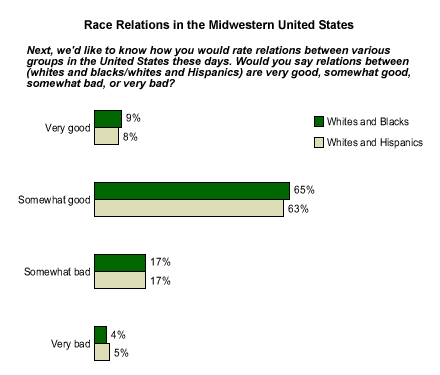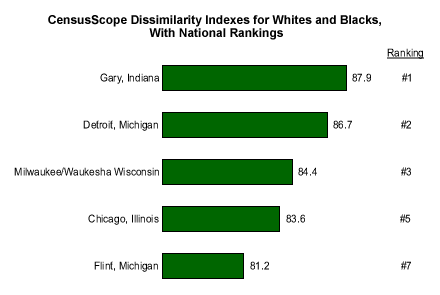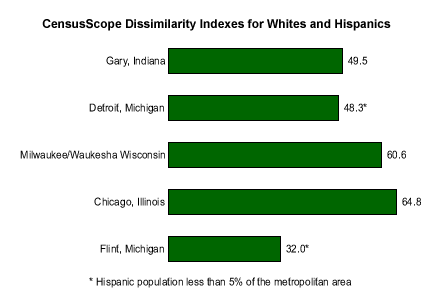This is the final article in a four-part series on race relations in four regions of the United States.
Over the past several weeks, we have considered race relations in three U.S. regions. This week, we will examine race relations in the Midwest*, the most homogeneous region of the country.
���۴�ýData on Race Relations in the Midwestern United States
Results from Gallup's 2002 minority relations survey** suggest that relations between whites and blacks in the Midwest are perceived slightly more positively than they are in the rest of the country. Seventy-four percent of Midwesterners rate relations between blacks and whites as "very good" or "somewhat good" -- a figure higher than the national average of 69%, and higher than any other region (the South is next at 70%). Conversely, the 17% who describe relations between whites and blacks as "somewhat bad" and the 4% who call them "very bad" are lower than their corresponding national averages.
Midwesterners have similar views on Hispanic/white relations. Eight percent call relations between whites and Hispanics very good, while 63% rate them as somewhat good. Only 17% rate relations between whites and Hispanics as somewhat bad, a figure lower than the national average and lowest of the four regions of the country. Five percent believe that relations between whites and Hispanics are very bad.

However, more specific questions about discrimination produce less encouraging figures in the Midwest. When asked if they feel that racial minorities in this country have equal job opportunities as whites or not, 46% said yes and 50% said no, compared to 47% who say yes in the East, 49% in the South, and 51% in the West.
Dissimilarity Indexes for Midwestern Metropolitan Areas
The CensusScope dissimilarity index (for a discussion of dissimilarity indexes, please see "U.S. Race Relations by Region: The East" in Related Items) indicates that metropolitan areas in the Midwest contain some of the most highly segregated residential patterns in the country. Thirty-four Midwestern metropolitan areas fall into the top 100 U.S. dissimilarity indexes for whites and blacks. In comparison, the East also has 34 metropolitan areas in the top 100, the South has 28, and the West has 4. Even more troubling is the fact that 7 of the top 10 metropolitan areas with the highest black/white dissimilarity indexes are in the Midwest.
Gary, Ind., has the highest white/black dissimilarity index in the Midwest region; in fact, it is the highest among all 318 metropolitan areas examined. Gary's dissimilarity index of 87.9 indicates that 87.9% of whites would have to move to another neighborhood in order to have whites and blacks evenly distributed across all residential areas. The white/Hispanic dissimilarity index is substantially lower, at 49.5.
In Detroit, blacks make up 82% of the population of the city proper, and almost a quarter of the population in the broader metropolitan area. The Detroit metropolitan area has the second-highest white/black dissimilarity index in the United States at 86.7. Hispanics make up a much smaller percentage of the population of this large metropolitan area, and their dissimilarity index is lower at 48.3. Another Michigan city -- Flint -- also ranks in the top 10 black/white dissimilarity indexes, coming in seventh with an index of 81.2.
Chicago, the largest and most cosmopolitan city in the Midwest, has the fifth-highest white/black dissimilarity index nationwide at 83.6. Blacks and Hispanics make up similar proportions of the population of the Windy City, yet again the white/Hispanic dissimilarity index is significantly lower at 64.8.


Key Points
According to CensusScope, the Midwest appears to be the most racially segregated region in the United States. Despite this finding, ���۴�ýdata show that Midwesterners do not view the current state of U.S. race relations more negatively than residents of other parts of the country. Are Midwesterners naïve in their assumptions that race relations are good because they have little opportunity to interact with people of other races -- or have racial groups in the Midwest found a way to maintain positive race relations while still living separately? Regardless, there is still room for improvement; less than 10% of Midwesterners describe white/black and white/Hispanic relations as very good. The Midwest, like other regions of the country, still faces a huge challenge when it comes to building a racially integrated -- and racially harmonious -- society.
*Gallup's Midwest region includes the following states: Ohio, Michigan, Indiana, Illinois, Wisconsin, Minnesota, Iowa, Missouri, North Dakota, South Dakota, Nebraska and Kansas.
**Results are based on telephone interviews with 1,360 national adults, aged 18 and older, conducted June 3-9, 2002, including oversamples of blacks and Hispanics that are weighted to reflect their proportions in the general population. For results based on the total sample of national adults, one can say with 95% confidence that the maximum margin of sampling error is ±3%.
